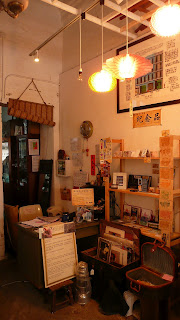Blue House is a known tourist attraction, but few out-of-town visitors would know about the 香港故事館 HK House of Stories (check out their facebook page, and also their website) situated in one of the old shop fronts on the ground floor.
I was there to check out their current exhibit held by the YMCA creative arts programme (runs until the 12th of April), whereby a group of post-80s youths were chosen to produce an art piece investigating their relationship with the past, represented through interviewing their own relatives from previous generations. These narratives are linked by the 'past and present' theme, and are also bound together by their common manifestation as a book (booking-binding pun intended.) They are not necessarily representative of an entire generation's approach towards the past, since they are highly personal (one decided to create a book shaped like a beer that was important to their interviewee, another recreated their grandmother's suitcase, and then there was an introspective account about one's changing relation with their father), but maybe this is more constructive in many ways? The post-80s youth are a diverse lot, and it wouldn't be fair to clump all of their voices together in a generalized summary.
Note: the exhibit is mostly (almost entirely) in Chinese.
One of the employees at the House of Stories was nice enough to give us more information about the place itself: the House is currently an exhibition space, but alternates between holding workshops and forums. It also provides a home for old items that belonged to the elderly residents of WanChai who were forced to move away because of the soaring rents/cost of living, a consequence of inflation and the continuous efforts from estate developers to gentrify the area. (For example, the employee gave rough approximates regarding the cost of the new apartments across the street targeted at young professionals. They used to be valued at around 9600 HKD per square foot, but within the past two years, this has jumped to 14000 HKD per square foot.)
All the furniture inside the House are donations from residents of WanChai, who have moved away and could not bring these possessions to their new abodes. These items aren't rare and expensive collectibles, but are chosen precisely because they were everyday objects that may still be seen and made today. The point is not to highlight to quirkiness of the past, but to make it relatable, allowing current visitors to see how the items were 'lived in' and used. (Alluding to the text by Appadurai about the 'Social Life of Things', whereby the object itself is not important, but rather the meaning and stories behind it.)
Collecting physical objects aside, the House also keeps a roster of all the people who moved away and where they are going, so that the previous residents and way of life won't be easily forgotten in this city where memory is fleeting.
The House of Stories focuses on 'community', especially on 'preservation through documentation'. Of importance is the changing forms of community ties, described as 'weakening' due to the modern way of life in Hong Kong. The old residential blocks, while often small and portrayed to be inhospitable domains, encouraged a sense of trust and mutual reliance through the establishment of communal facilities such as kitchens and bathrooms. These community ties don't always infer close friendships between people (to the point where they will share their life secrets with each other), but to a sense of obligation and responsibility towards the well-being of neighbours.
In contrast, the employee argued that the structure of our current living quarters, which places emphasis on being self-contained and uses 'privacy' as its selling-point, has greatly contributed to the disintegration of these ties between people. While I feel uncomfortable saying that community ties are 'weakening' (as opposed to using neutral terms such as 'changing'), it is also true that we oftentimes have no idea who our neighbours are. When was the last time we talked to someone who lived next door to us, or could warmly receive a neighbour who has come over to borrow soy sauce/other household goods without making us suspicious?
I'm also reluctant to implicate the diminishing community ties simply to the changing layout of the structures we now call home (the changing physical forms of housing, and how it impacts our social lives, will be discussed in another post soon.) Afterall, are communities molded only by the physical environments, without accounting for other variables such as input from the complexities of personality? It could easily be said that the changing traits of human sociability should instead be scrutinized when looking at changing community ties. Which then leads to a chicken-or-egg discussion on whether our sociability affected the building types that emerged, or whether our behaviours are shaped by the buildings we are faced with in our daily lives....
Anyways, the Hong Kong House of Stories is a good place to visit for its architecture, its current exhibition, and maybe just for a chit-chat like we had with the employee there. It is located in WanChai, on 74 Stone Nullah Lane.







Nice post, I really like the way you share the information. Thanks
ReplyDeleteFurniture Shop in Hong Kong | Sofa Hong Kong